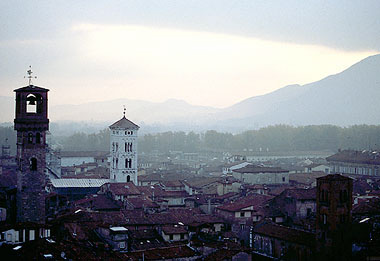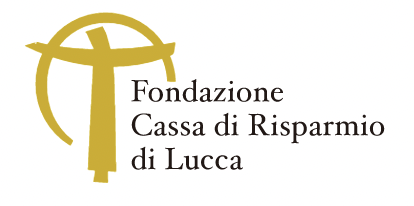
The Province of Lucca is divided into 34 municipalities; only 6 of them are in the plain. One of the largest in Italy is the municipality of Capannori with its 40 hamlets. The other centres are Altopascio, Montecarlo, Porcari and the small commune of Villa Basilica. The Piana di Lucca is of course flat, but it is surrounded by beautiful hills set against the background of the Pizzorne highlands on one side and the Monti Pisani on the other.
The origin of most villages is Medieval, but recent archaeological excavations have shown that settlements existed in this area since the Bronze Age. After, the territory remained uninhabited for a long time; however, from the beginning of the Vth century B.C., the Etruscans appeared in the region of Fossa nera near Porcari followed, much later, by the Romans.
With the arrival of the Lombards and the creation of new roads, among them the Via Francigena, the population begun to increase. Because of the frequent passage of armies and mercenary troops the villages were fortified; the unhealthy conditions in the plain, especially close to the marshes around the lake of Bientina, prompted the inhabitants to move to the hills.
The Piana di Lucca with its suggestive landscape and well rooted folklore has, therefore, a very rich history.
Details:
The plain of Lucca was inhabited since the Bronze Age, but not continuously, since it was deserted in some periods. Archaeological records show that after the first settlements this area wasn't populated for a long time. Only in the Vth century b.C. the Etruscans arrived and new settlements were established. Much later with the arrival of the Romans and, at the end of the VIth century A.D., of the Lombards, the whole area of the plain was reorganised. A very important road, the Via Francigena, was opened and gave rise to new villages, today important municipalities of the plain. All around the Via Francigena began a growth of new settlements, fortresses and hospitals, such as that of Altopascio, built in the middle of the XIth century for pilgrims on their way to see the Volto Santo in Lucca or bound for Rome or Jerusalem.
During the Middle Ages the government of Lucca constantly repaired and strengthened the fortresses in the plain as a bulwark against the frequent raids and the advance of the Florentines from Val di Nievole. Here fierce battles which saw the participation of Lucca, Pisa and Florence were fought. After the destruction caused by the army of Uguccione della Faggiola, captain of the Pisans, Castruccio Castracani, lord of Lucca, drove back the Florentine army at Altopascio in 1325. But the wars continued since the Via Francigena was an important passage for armies and mercenary troops.
After the government of Paolo Guinigi, the Florentines succeeded in conquering the strategic fortress of Montecarlo and the area went through a long period of decadence that lasted, with alternate phases, until the Renaissance; all this as the vital silk trade began to decline.
With the opening of the important Via Francigena and the descent of barbarian peoples from northern Europe, many villages in the plain were fortified. During all the Middle Ages castles and watch towers were built and later renovated. The frequent passage of armies and mercenary troops across the territory prompted the nobles to fortify their residences, while the unhealthy conditions of life in the plain, especially close to the marshes around the lake of Bientina, prompted the inhabitants to move onto the hills.
The hills around Capannori are covered with castles: these were not just military garrisons guarding the roads towards Pisa and the lake of Sesto, an important waterway for Lucca that no longer exists today, but also proper villages, albeit fortified. They were, indeed, built in places where grapes and olives could grow, so the village could live on agriculture and be self-sufficient.
The strategic positions ensured an easy control of the territory and at the same time were not affected by the stagnant, unhealthy waters. Unfortunately for us a great number of castles was destroyed and at the moment excavation campaigns have been carried out only in few places. One of the best examples, the fortress of Montecarlo, is, however, very well preserved and shows evident signs of the successive structural changes prompted by the introduction of new techniques of warfare, when the fortress and village had to be surrounded by impressive walls to protect them. The Medieval towers were nearly all demolished, though some of them were incorporated into new buildings. One of the best preserved is the tower of Sant'Andrea di Compito in the municipality of Capannori.
Many roads used to cross the Piana di Lucca and even climb the slopes of the Monti Pisani and the Apennine; of these, by far the most important is certainly the Via Francigena that was essential for the development of the plain. From Lucca the Via Francigena turned north towards Borgo a Mozzano; in the other direction it crossed the present day communes of Capannori, Porcari, Altopascio, continuing east towards Fucecchio. One leg also descended the Freddana valley until Camaiore.
Villages, fortresses and hospitals such as the one founded around the middle of the XIth century in Altopascio to care for the pilgrims on their way to see the Volto Santo in Lucca or heading further towards Rome or Jerusalem, all rose around the Via Francigena.
The Via Francigena as such was opened by the Lombards. The new rulers traced the road connecting their capital Pavia to the southern kingdoms between the VIIth and VIIIth century A.D. Distant as it was from the coast and its pirates, the road became a vital nerve for the development of the hinterland.
At the time of the Franks, successors of the Lombards, the road became known as Francigena, the highway of Christianity used by pilgrims bound for Rome or Santiago.
All the communes of the plain indiscriminately owe their origin and further development to this important route of communication.





